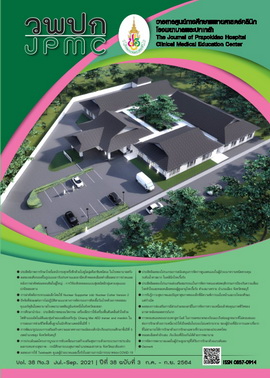Evaluating The Health Promotion - Driven Integrated Project by Health Impact Assessment Process: A Case Study of Health System in Phanom Sarakham District, Chachoengsao Province
Main Article Content
Abstract
BACKGROUND: Health impact assessment (HIA) is a systematic tool for monitoring and evaluating the health projects.
OBJECTIVES: To evaluate the productivity and process of the health promotion - driven integrated project by HIA process in Health Region 6, in Phanom Sarakham district, Chachoengsao province
METHODS: The data were collected, based on HIA process, from three sources: 1) documents and database of Tambon Health Fund (THF), 2) seven teamwork members of the integrated project at both national and regional levels, and 3) twenty - nine local teamwork members. Tools for data collection included interview form, group discussion guide, and data record form. The qualitative data were validated through triangulation and analyzed by content and descriptive analyses.
RESULTS: The performance was in line with the productivity of the integrated project, covering health promotion and quality issues of the program and project in Tambon Health Fund. However, application of the online monitoring and evaluation was not detected in working system. The implementing results, based on the Ottawa Charter Framework, were showed that, in the personnel development, there was a potential development of mentor team in the project preparation and database system but no potential development of the fund committee and project organizers. In the environmental adjustment, it was found that planning and project development systems were taught through actual operations and consultation from the regional coordinators. In the operation system, it was that the district health fund committee operated in a traditional fashion with an increasing trend of utilization of database development system, plans and projects. In the community strength and public policy development, there was no concrete change, but there was a trend in coordination with the work of the district committee for quality of life development.
CONCLUSIONS: Applying HIA process for project evaluation is a very empowering and valuable way. Evaluating the integrated project by the HIA process can assist the assessors and organizers to see both weaknesses and strengths of the driving process including the observable and practical outcomes of project implemented in local areas.
Article Details
References
Kerzner H. Project management: a system approach to planning, scheduling, and controlling. 12th ed. New Jersey: John Wiley & Sons; 2017.
Kanjanawasee S. Evaluation theory. 9th ed. Bangkok: Chulalongkorn University Press; 2019.
Pongsupap Y. Draft document of regulation of the official of the Prime Minister on district quality of life development committee B.E. 2560. Nonthaburi: The Graphico System; 2017.
National Health Security Office. Local health security fund manual 2019 1st ed. Bangkok: Saen Chan Press; 2019.
Thai Health Promotion Foundation. Thai health promotion foundation annual report 2019. Bangkok: Thai Health Promotion Foundation; 2019.
Suthervut P. Monitoring and evaluating system of health promotion project of the Thai Health Promotion Foundation. Proceeding of the health promotion project assessor network development workshop; 2020 February 29 - March 2; Bangkok, Songkla, Public Policy Institute, Prince of Songkla University; 2020.
National Health Commission Office. Health impact assessment manual. 2nd ed. B.E. 2016. Bangkok: Supa Printing; 2016.
Sutipanwihan S. Public screening, public scoping. Proceeding of the health promotion project assessor network development workshop; 2020 February 29- March 2; Songkla, Public Policy Institute, Prince of Songkla University; 2020.
Quigley R, den Broeder L, Furu P, Bond A, Cave B, Bos R. Health impact assessment international best practice principles. IAIA 2006; (Special publication series N.5): 1-4.
Lock K. Health impact assessment. BMJ 2000 ;320(7246):1395-8.
World Health Organization. The Ottawa Charter for health promotion [Internet].1986 [cited 22 September 2020]. Available from: https://www.who.int/healthpromotion/conferences/previous/ottawa/en/

